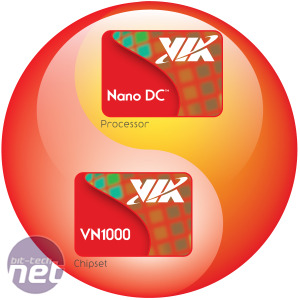Performance Analysis and Conclusion
After our frustrating experiences with its Artigo A1100, frankly VIA can't get its dual-core CPU out fast enough: it's precisely what the company needs to keep a level of interest in its hardware.General CPU performance might be firmly ahead of Intel's Atom, but it falls short of the CULV Core 2 Duo: a part that's now nearing the end of its life. The advantage of the Core 2 Duo's common L2 cache between both cores is clearly apparent when we consider the SU7300 has a clock speed of only 1.3GHz, versus the Nano Dual-Core at 1.8GHz. Even then, the TDP of the SU7300 - which, bare in mind has 1MB more cache to power - is around 10W less than VIA's anticipated final TDP when the Nano Dual Core moves to 40nm. That's a considerable downside for VIA if it wants this CPU to be seriously considered for laptops - ultra-thin or not.
 In some respects it's actually the VN1000 IGP that really makes the VIA platform worth having, as it can actually play a few games, unlike Intel's older GMA 4500MHD hardware. That said, it still needs considerable driver optimisation to get the most out of its 32-shader hardware, especially in video playback. Discussing this with VIA, it still has faith that its software team will iron out the bugs as the platform matures in the coming months.
In some respects it's actually the VN1000 IGP that really makes the VIA platform worth having, as it can actually play a few games, unlike Intel's older GMA 4500MHD hardware. That said, it still needs considerable driver optimisation to get the most out of its 32-shader hardware, especially in video playback. Discussing this with VIA, it still has faith that its software team will iron out the bugs as the platform matures in the coming months.Lets not forget AMD though; its first Fusion parts; Zacate and Ontario, are also due by the time VIA gets its final Nano Dual-Core hardware out next year. Both use TSMC's 40nm process, but AMD not only blends both cores into one to save power, it has multiple clock domains, plus an integrated memory controller and an 80-shader DirectX 11 GPU.
All this is supposed to squeeze into a TDP of 18W for the Ontario die - very close to VIA's anticipated TDP of its Nano Dual-Core. Until we see final hardware from both companies this is all still speculation of course, but considering we've already seen the merits of a shared L2 cache on the Core 2 Duo in our tests, and given preliminary test results, it's a logical estimation to assume AMD will have the advantage by having virtually everything integrated. Time will tell on that front.
If that turns out to be true, what concerns us is how VIA can market its Dual-Core hardware? It previously push the merits of the Nano's out of order execution as a 'more efficient' advantage to Intel's Atom - while it also had an advantage in the GPU stakes - while AMD all but ignored the netbook market. With AMD bringing low-TDP processors with out-of-order execution to thin-and-light laptops, VIA simply cannot go head-to-head in the same market, it needs to compete elsewhere, but that's something AMD is already doing to sell against Intel!
All that is some way off in future though, and on a positive note we respect the merits of the Nano Dual-Core, in that VIA finally has some capable hardware. While the Nano Dual-Core probably won't be the best out there, it's reasonably nippy, it can play games, and it's pretty low power. In a nutshell, it's a viable alternative with a decent balance of performance between CPU and IGP, and such alternatives are always needed.

MSI MPG Velox 100R Chassis Review
October 14 2021 | 15:04









Want to comment? Please log in.